Hardcastles of McClain County Oklahoma
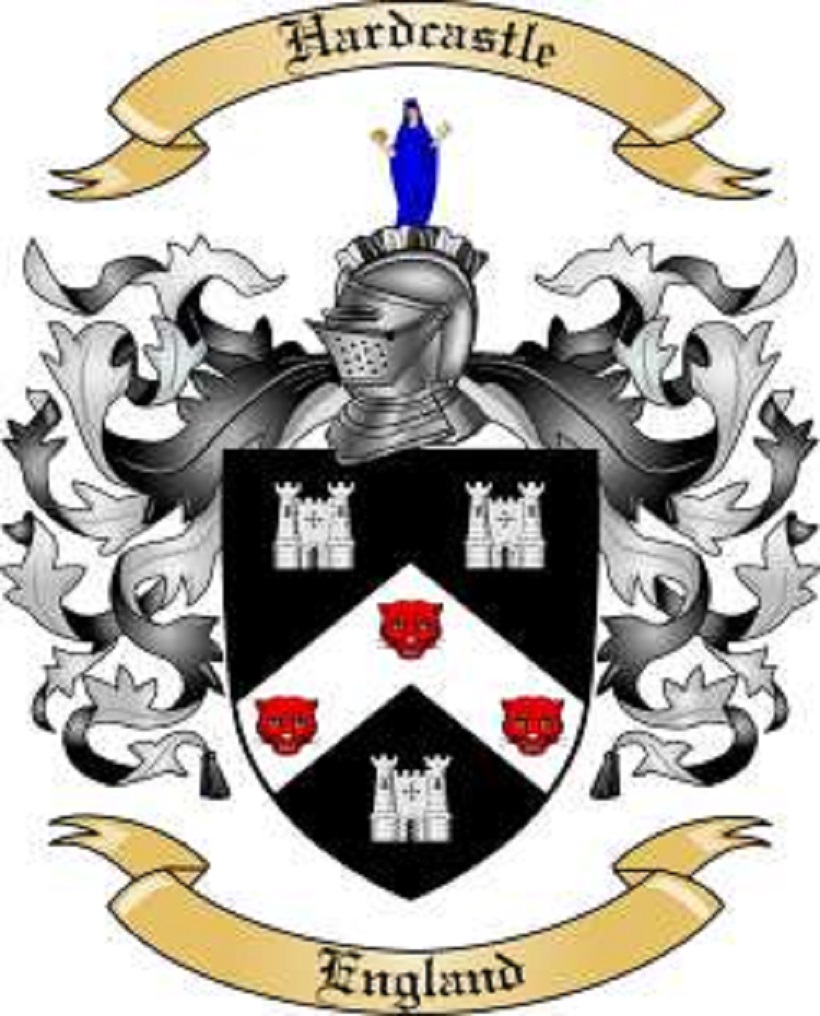
The first phase of this journey will be told with respect to the individual men of our
Hardcastle line, going back as far as I have names for them. Though we probably never
will know the names of earlier men, there is still quite a story to tell of those times.
The second phase will take our line back to England, and how the line's Y-chromosome
tells us where they came from before the advent of human civilization. The final phase
will cover the rest of the family tree of Thomas Hardcastle, my great-great grandfather,
through all of his great-great grandparents. Keep in mind that most of them lived their
lives before the Revolution.
Our Hardcastle line is one of the more interesting in our tree. I don't say that because
it's the one I grew up closest to, that Elva Hardcastle was my only great-grandparent I
ever met. It's interesting due to the uniqueness of the name, and good documentation
that allows us to trace it unusually deep into the past. And it's interesting because of
its time in America, going back to the early years of Virginia.
Hardcastle in America
Below is a photo of my great-great-grandfather Thomas Hardcastle. He was born in Logan
County Kentucky in 1874. By the time he was a teenager in 1891, he came with his father
to Newhope, Pike County Arkansas. He settled in Star of the West by 1893 to raise his
own family, southeast of Glenwood. The line was in Arkansas for about 30 years before he
moved on to McClain County Oklahoma about 1817. Thomas registered for World War I at the age of 43.
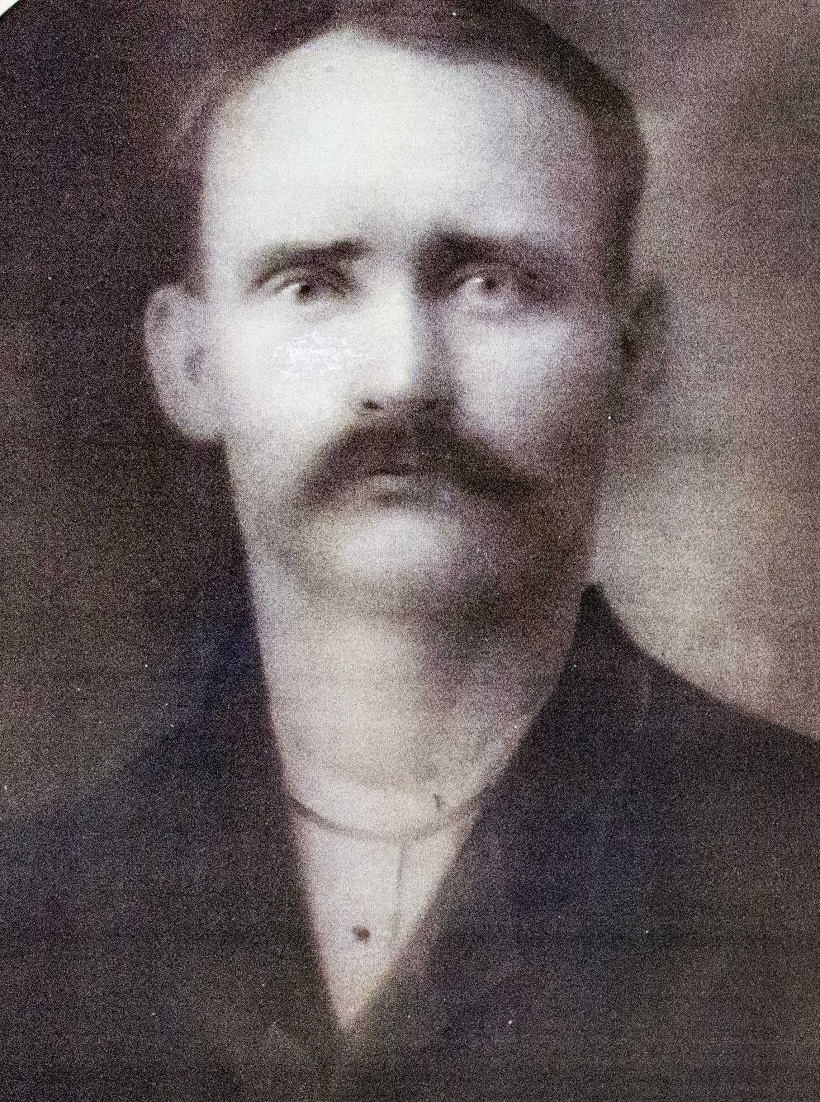
Thomas Hardin Hardcastle
Thomas's father was Joseph Lafayette Hardcastle, born 1845 in Smith County Tennessee.
Joseph came with his father to Kentucky as a youth and raised his own family in Logan
County. Joseph was a Union soldier. You see, Kentucky was the great North in my family
by the time of the Civil War. Joseph was part of the Kentucky Active Militia, the Capitol
Guard in Frankfort. It was formed in response to a confederate attack. This occurred on
June 11 1864, and Joseph was registered as part of the Guard the next day. He served until
the following January, and no more confederate attacks occurred. I found the photo below of the
Guard. I don't know the names of these men, but quite possibly one of them was Joseph.
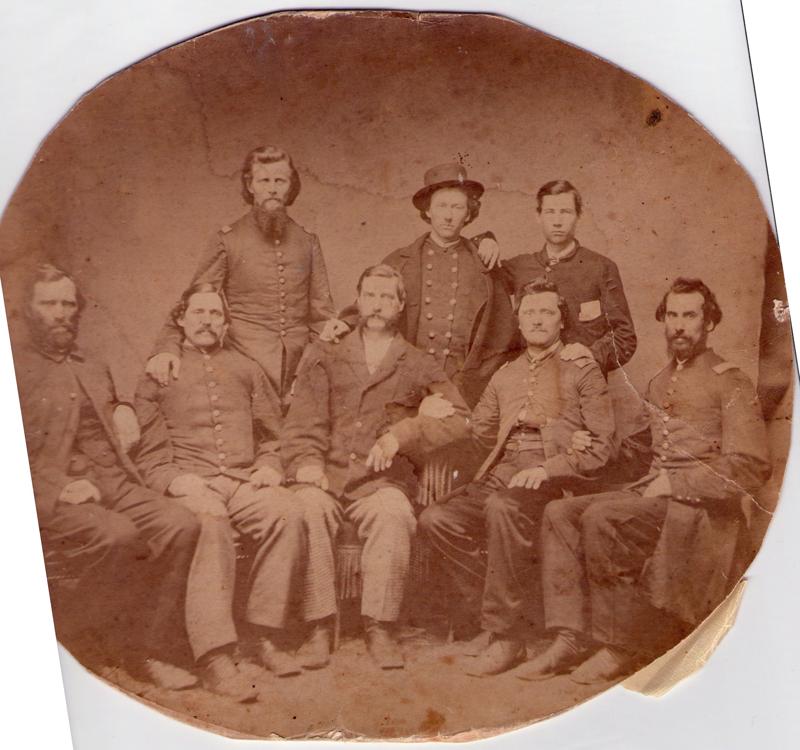
Kentucky Capitol Guard
Our Hardcastle line's 30-plus years in Kentucky were during Joseph's lifetime. His father
was Hardin Noel Hardcastle, born 1815 in Rutherford County North Carolina. Hardin went
with his father as a toddler to Tennessee. Our line's almost 40 years in Tennessee fell
during his lifespan. One odd thing to note about Hardin is his appearance in a death
index in Logan County Kentucky. His parents were listed as John and Mary Hancock. I have
no idea why that happened, but DNA ThruLines help to prove that his father was John
Hardcastle. For a long time I didn't know what his mother's maiden name was, but it wasn't
Hancock. I had a hunch that the name Hardin came from an ancestor, and I confirmed using
ThruLines that it came from his mother. See the Hardin section of the last phase of this
document.
Hardin's father John was born about 1780 in Johnston County North
Carolina. He moved to Rutherford County North Carolina to start his own family. He was
mustered there for the War of 1812, in the North Carolina Militia, though I don't know if
he saw action. John's father was Elisha Hardcastle. Elisha was born in Gloucester County
Virginia in 1752. His father relocated the family to North Carolina in 1763. Elisha was
24 when the Revolutionary War broke out. I've found no record of his involvement, though.
Elisha's father was William Hardcastle. He was born in New Kent County Virginia
in 1728. He received a land grant that prompted the move to Johnston County North
Carolina. That grant was in 1763, and possibly was related to service in the French and
Indian War. His move began a span for our line in North Carolina of 60 years.
1728 was quite early in American history. But would you believe that our Hardcastle line
arrived here over a century earlier? Its entire time in Virginia was 140 years. John
Matthew Hardcastle first landed in 1624, a very early settler of the Northern Neck, in Old Rappahannock County.
This was 17 years after the founding of Jamestown, and the same time that the Morrises on
my Scott side landed in Massachusetts in the wake of the Mayflower's arrival. The
population of all of Virginia was a few thousand in 1624. It would be about 5000 by 1634.
It was in 1624 that King James took control of Virginia from the London Company and
changed its mandate from making a profit into being settled for England. I expect it's
not a coincidence that John Matthew Hardcastle came to Virginia at that time. See the map
below of early settlements on the James River.
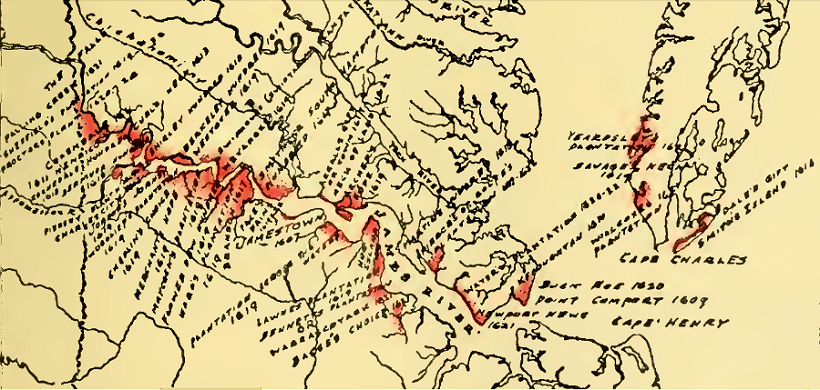
Virginia Colony in 1622
New Kent County was established 20 years after our Hardcastles were already in America.
Virginia had yet to form counties at all in 1624. The first divisions of land were called
shires, begun in 1634. Our Hardcastles moved to Charles River Shire, to the northwest of
Williamsburg. Williamsburg didn't become the capital of Virginia until our Hardcastles
had been there over 70 years. It was a very rural existence. New Kent County didn't have
an incorporated town until 1680. The total population of New Kent County today is under
20 thousand, so it's remained largely rural. John Matthew Hardcastle landed in Virginia
in the aftermath of the 1622 Powhatan Massacre. See an illustrative interpretation of
what that might've looked like, below.
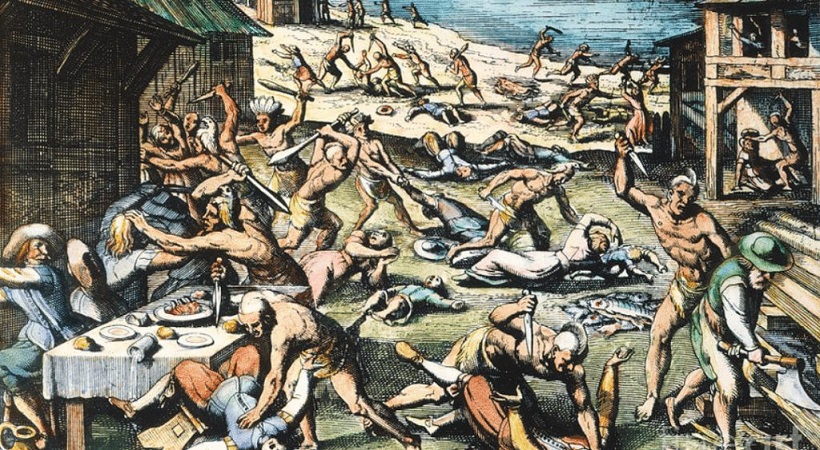
Conflict with the Powhatan didn't slow down the continued population growth which our
Hardcastles were part of. Charles River Shire became York County in 1643, and York
eventually was cut down to the area around Yorktown. New Kent County was formed in 1654
by William Claiborne. Claiborne Wright of the McAtee story got his name through relation
to the Claibornes. William Claiborne had been a prime instigator of Ingle's Rebellion in
Maryland. I expect that neither Wright nor William McAtee knew of the Maryland history
they shared. William Claiborne must've been a compatriot of John Hallowes, as Claiborne
had settled on an island that became part of Maryland. Ingle's Rebellion grew out of
Claiborne's irritation at a Catholic colony that insisted he lived within it and not
Virginia, combined with the English Civil War starting on the other side of the Atlantic.
The line of descent to us from John Matthew that were born in Virginia was Henry Matthew,
John, William, John, and then William who went to North Carolina. New Kent County is
said to have been a land of plantations and luxe estates. I expect that our Hardcastles
weren't just scraping by. I had wondered if lack of prospects is what caused our line to
eventually migrate south and west, but back in the 1720s there weren't many options in
Virginia so they might've left even earlier otherwise. Unlike our McAtees in Maryland, I
expect our Hardcastles had been able to pay their own passage to America with ease, and
brought their wealth with them. That said, I'm not aware they ever became slaveholders.
ThruLines solidly supports our Hardcastle line up to William of North Carolina, when it
gets too deep in the past to help. There were a couple of small hiccups along the way
tracing our line back to Virginia, but there's no reason at all to doubt its accuracy.
And unlike other lines in the family, the known Hardcastle path continues back well beyond
the point of immigration. Before we move on to the other side of the Atlantic, I'll note
here that though our line came so close to Jamestown's founding, I've identified no
descendant of that first English settlement who married into our Hardcastle line. They
seem to all have been later arrivals to Virginia.
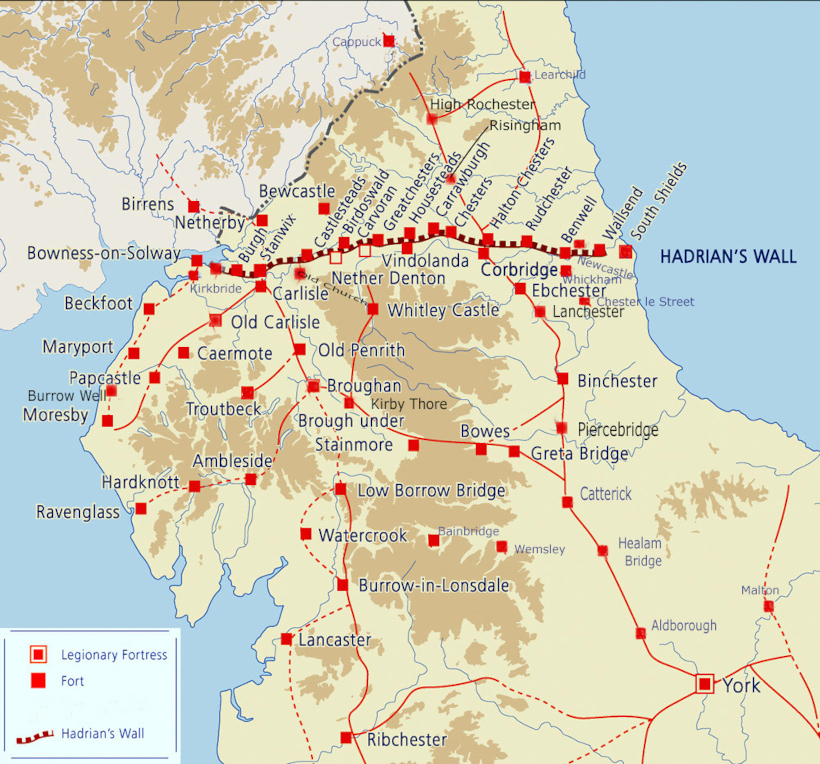
Hardcastle in Britain
The Hardcastles are English. The name comes from a tower the family operated on Hadrian's
Wall. It may be that they had no ownership of any particular building, but that they only
manned it. I'm not sure of the exact location, but it was the eastern part. There's no
Hardcastle Tower today, and it only exists in family lore. But it could've been anywhere
from South Shiels at the east coast to Corbridge. See the map above. It's possible that our Scott and
Hardcastle lines crossed paths in Roman times. They were on opposite sides later, which
I'll get to very soon. Corbridge is where the Dere Street crossed the Wall, which also
factored into the Scott story. The structure the Hardcastles named themselves after
could've actually been a Roman fort. It also could've been a Norman castle added to the
remains of the Wall after 1066.
There is more to discuss here about the Roman times, but for now what I can tell you is
the Hardcastles were in conflict with Scots in the 13th century. The lands around the
eastern part of the Wall, after having been part of the Kingdom of Northumberland, became
a debatable zone, contested by the English and Scots. The Hardcastles left at that time
and went south to settle in Yorkshire. John Matthew, the emigrant to Virginia, was
born in Yorkshire. The earliest known man of the line was Richard de Hardcastell, documented in
Yorkshire in 1358. John Matthew's father was William. His father was Thomas. His father
was Robert. His father was Miles, who was born in 1486 at Pateley Bridge. The names of
the men between Miles and Richard are no longer known, but there couldn't have been more
than five or six of them.
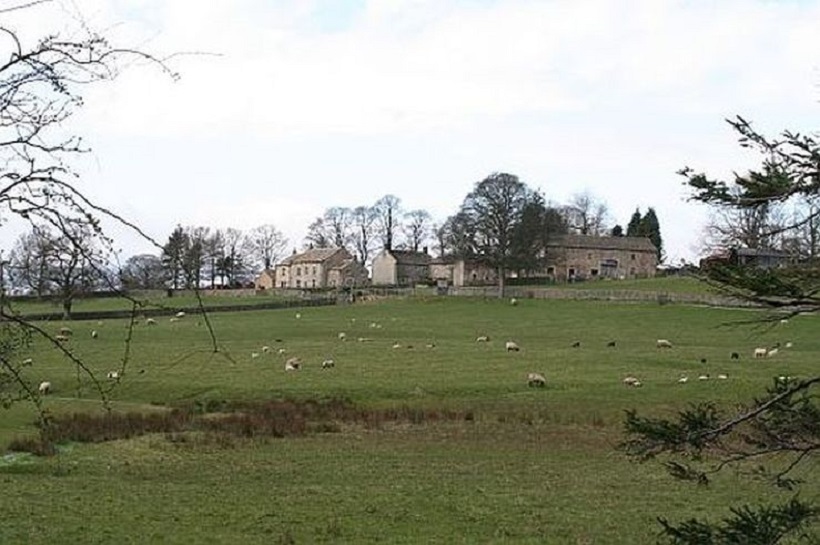
Hardcastle Garth today, in Yorkshire
The path the Hardcastles took in their flight south would've been down the Dere Street,
bolstering the idea that they had been at Corbridge. They've moved around a bit within
Yorkshire since, and some have spread around England and Scotland, but the site today that
carries the name is Hardcastle Garth. This is in Nidderdale, a few miles southeast of
Pateley Bridge, and 30 miles west of York. Evidently Pateley was named only after a road
and bridge until 1661, when a village formed. This was after our line left the area
entirely, so it's probably not accurate to say that any of them were born in Pateley
itself. But they had been in the vicinity. It was an upscale rural scene probably not much
unlike what our line moved to in Virginia, except they came into a warmer climate.
Let's look for a moment at the form the name had in the earliest document: de Hardcastell.
The 'de' shows that this is so far back in time, French still held sway over the
upper class, which started with the Norman Invasion in 1066, and the Hardcastles were
upper class. It looks to me like the language didn't change until Thomas son of Robert.
I saw the latter written as Robard in a document. They definitely spoke with French
accents back then. And what about castell instead of castle? French for castle is
chateau. Castell is actually Latin. I wonder how far back the Latin influence on the
name Hardcastell went. Did they choose that form because they knew Latin? Could it
actually go all the way back to the Romans? Did our Hardcastles define themselves
beginning with manning their tower on the Wall at the time it was built? Maybe it was
merely because Latin remained the language of education. It's interesting to wonder.
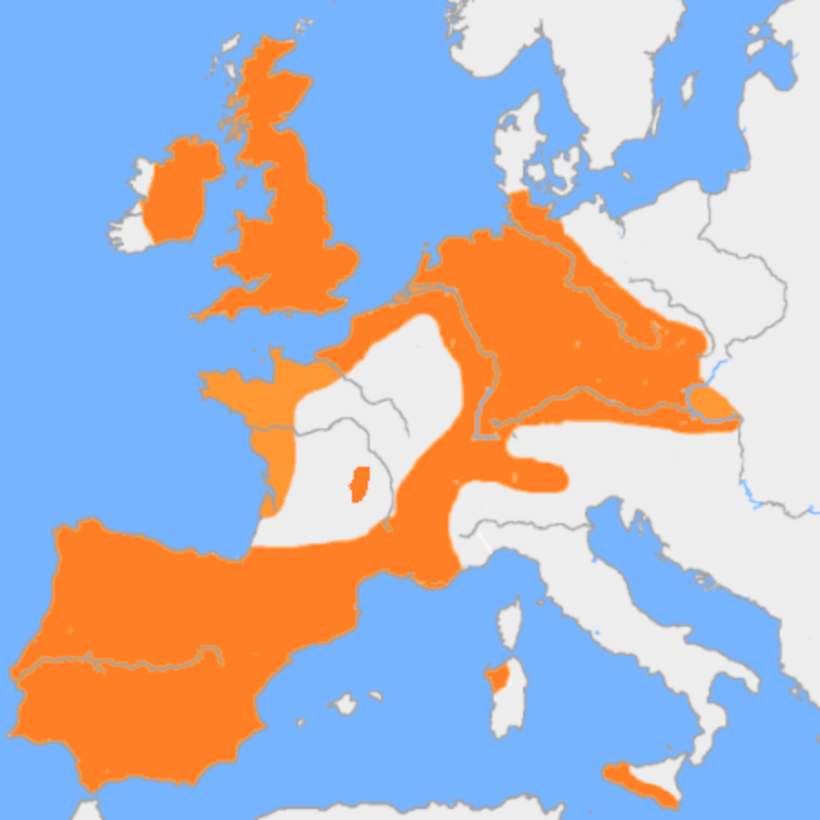
Bell-beaker cultural area, circa 2500 BC
And on that note, let's go back in time in this narrative by a larger amount. Our
Hardcastles were English, but they weren't actually Anglo-Saxon in origin. The line's
Y-DNA is R-M269, the Celtic haplogroup. More of my ancestors were of that haplogroup
than any other. That's not surprising, as it's the dominant source of men in Europe
today. Let's deal with it in detail here. R-M269 originated in central Europe about
5000BC. Our Hardcastle line, along with the many others in our tree, were likely part of
the agrarian Beaker people who entered Britain about 3000BC. See the map above. It's also possible that they
were Normans and moved a long time ago to what would become Normandy and were Gauls. See
the image below of what a Celtic homestead before Roman times would've looked like.
The Celts were also known to live in hill forts, where earthworks were constructed around
a hill for defense against raids by enemy tribes.
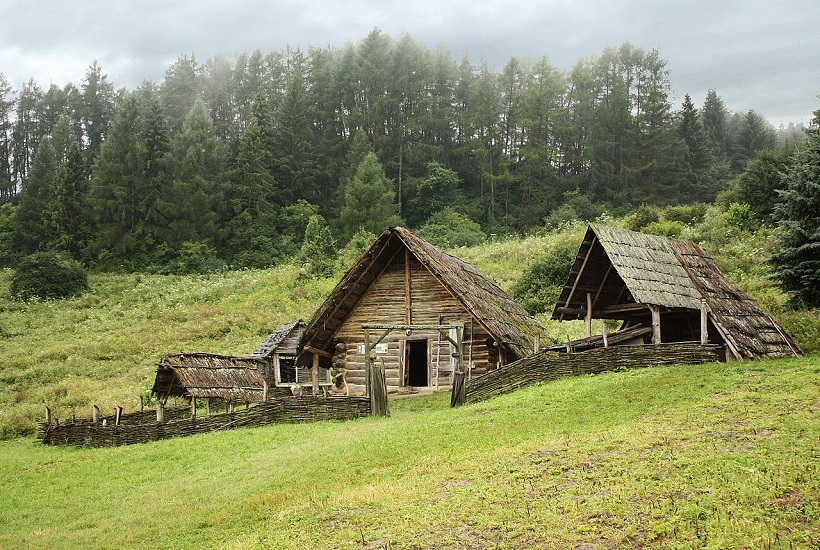
A Celtic home - bears not a small resemblance to an Appalachian one much later
Assuming that our line were early Iron Age immigrants to Britain, they obviously made
their way over time to the north of modern Yorkshire. They were likely part of the
Brigantes tribe of Celts that spanned all around that area. They fought hard against the
Romans but eventually were conquered. See the image below of a reconstruction of what a
Celtic warrior would've worn in combat with the Romans. The Gauls were similar.
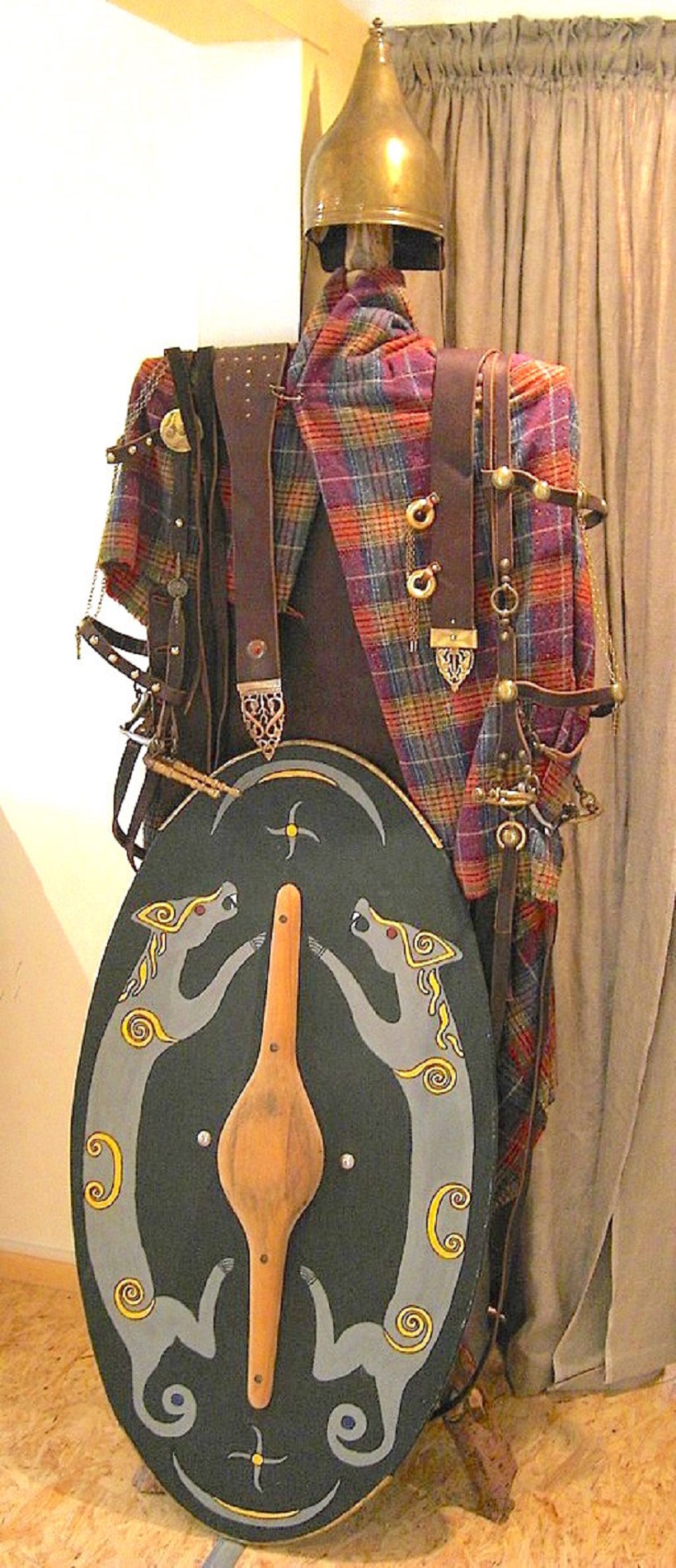
Celtic warrior garb
Though our line went from being Celtic to Roman to English, that doesn't mean
they adopted the changes willingly. But their settling of Virginia so early and their
apparent wealth indicates that they were as English as any line we have. See two more
maps below, of 150AD in the Brigantes tribe, and of 600AD when Anglian culture formed the
Kingdom of Northumberland amongst the Romanized Britons like our line. It's not
impossible that our Scotts helped directly to drive the Hardcastles away from the Wall,
as much as a millenia since they first occupied it. In 1314 Robert the Bruce ravaged
Northumberland. Hardcastle lore says they left in the 13th century, and I wonder if a
specific battle was the reason and not reivers.
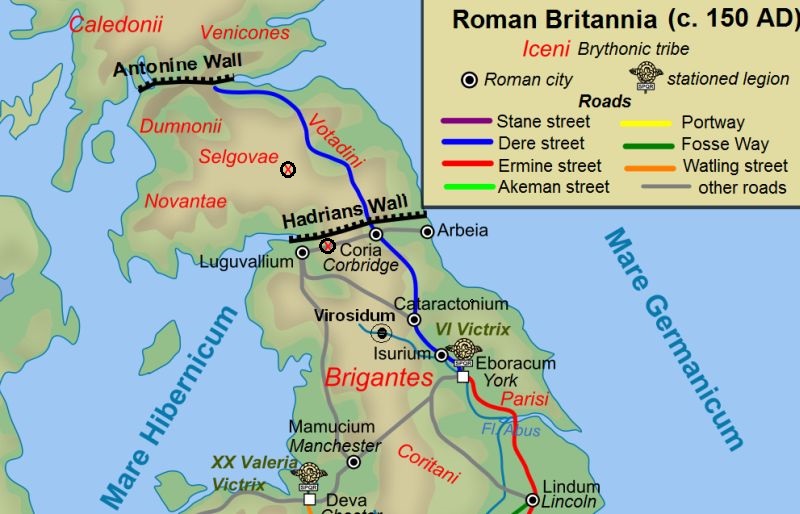
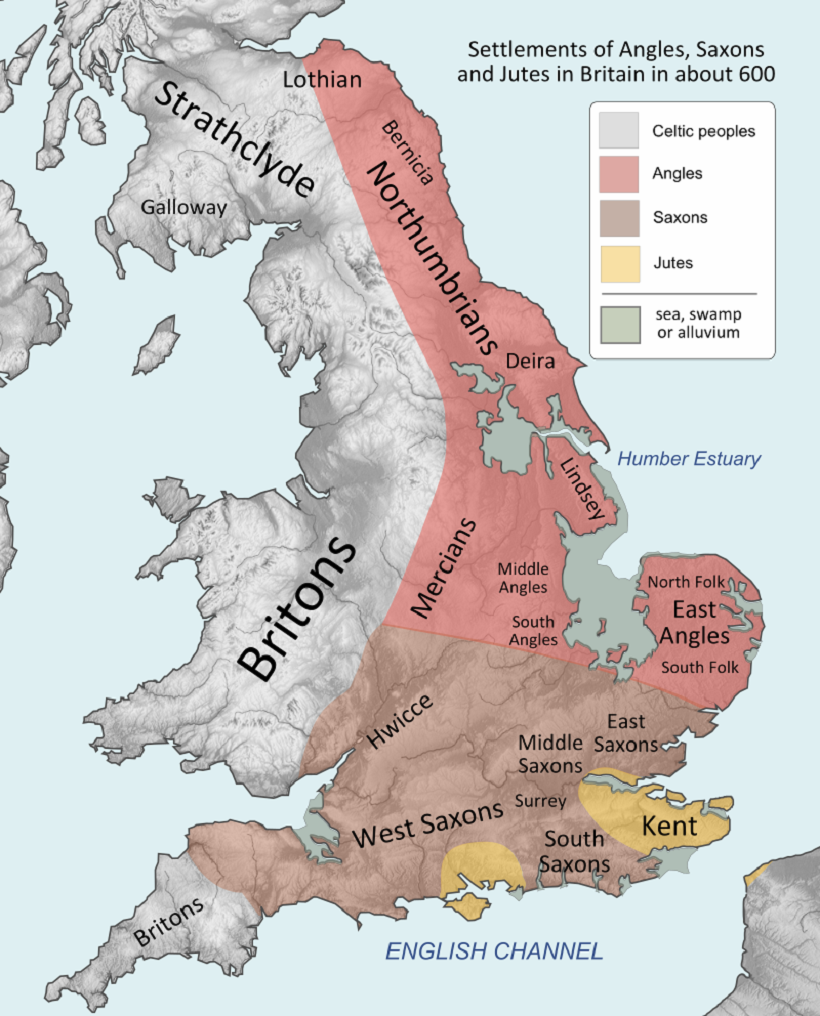
Thomas Hardcastle's other Great-Great-Grandparent Lines
In the last phase of this document, I collect all that I know about the non-Hardcastle paternal lines of the great-great-grandparents of my great-great-grandfather, Thomas Hardcastle. Refer to the McAtee Pedigree page for a simple view of Thomas's ancestors.
Smith
Thomas Hardcastle's mother was named Narcissa Catherine Smith, born 1855 in Coffee
County Tennessee. Narcissa (not surprisingly) didn't like her name, and went by "Bi"
as in the second Catherine after her mother. Bi Hardcastle's final resting place was
Atoka Oklahoma. Bi's father was John Quincy Adams Smith. He obviously was named after
John Quincy Adams. Now, President John Adams's wife, and mother of John Quincy Adams,
was Abigail Smith. Let's come back to this when I've traced our line further. Our
JQA's father was William Smith, born 1804 in Rutherford County North Carolina. William's
father was James Smith, born 1776 in Brunswick County North Carolina. James's father was
John Smith, born 1730 in Berkeley, Perquimans County North Carolina. John's father was
James Smith, born 1691 in Perquimans. James's father was also named James, born 1665 in
Perquimans.
The tree I have on ancestry.com ends here. At the time I did the work, I felt that the
name Smith was so common that I couldn't know how the line went back. But considering a
potential relation to Abigail Adams, I took another look. Geni.com does trace our line
back further. It has James 1665's father as Robert Smith, born 1657 in Middlesex County
Virginia. There's an obvious problem with this, namely that Robert would've been 8
years old when James was born. Also, Geni's info has Robert living all his life in
Virginia. Actually, the oldest Robert was at the birth of his sons on Geni was 18. But I
think our line did come from these Smiths. It could be that Robert was James's older
brother and previous researchers have the tree a little scrambled. It's also possible
that James was born in Virginia, especially as early as 1665.
This Geni line goes back through Peter born 1640 in Lincolnshire, to William born 1615 in
Staffordshire, to Thomas born 1594 in Yorkshire. This is obviously shaky, but so is
Abigail Smith's line. Her father was William Smith, born 1705 in Massachusetts. William's
father was William Smith, born 1667 in Massachusetts. William's father was Thomas Smith,
born 1645. The location of his birth is unknown. Compare Thomas 1645 and William 1705 in
Abigail's line to Thomas 1594, William 1615, and Peter 1640 in our line. Now, granted,
names like William Smith and Thomas Smith were common names back then, and even now. But I
get the feeling that our John Quincy Adams Smith had more meaning in his name than, say,
Thomas Jefferson Draper or George Washington Carlile. I believe that Thomas Smith born
1594 was an ancestor of future President John Quincy Adams. This common ancestor is many
generations back, and maybe our JQA's parents weren't aware they were related. But it
looks like they were. Presumably our line was Anglican. I've seen no evidence of
slaveholding. I found one claim of descent from James 1665 in the Smith DNA project, who
was tested as haplogroup R-M269. I found no clear connection to the Abigail line, but I
think most Massachusetts Smiths were R-M269.
Taylor
I knew for a long time that Joseph Hardcastle's mother was Mary Ann Taylor, born 1817 in
Smith County Tennessee. Or, I had that info for her, but I had no idea who her parents
were. She was such a mystery that I even pursued the possibility that her maiden name was
Hardsonhack, based on an ancestry.com hint, presuming she actually was part of the Holsonbacks. But that didn't lead
anywhere. Once I learned how to use ThruLines to fill out the family tree, I began this
line by assuming that Mary Taylor was accurate. I manually searched the 1840 Smith County
census, and found several Taylor/Tailors. I zeroed in on Daniel Taylor, born 1785 in
Sumner County North Carolina, who died in Smith County. ThruLines reacted
tepidly, with only two matches. But in my experience, this either is a confirmation that
Daniel was an ancestor, or Mary's father was his brother. I presume Daniel is accurate,
because when I entered his father Daniel, born 1748 in Orange County Virginia, ThruLines
returned 8 matches. This isn't a terribly large amount at that position in the
tree, but it certainly is enough to indicate a direct ancestor. So, Mary Ann Taylor had
been correct all along, and now I found a way to prove it.
Daniel Sr was a soldier in the Revolutionary War. His father was George Taylor, born
1724 in Fairfax County Virginia. George's
father was also named George, born 1704 in Fairfax. George Sr's father was John Taylor,
born 1671 in St Mary's Maryland. John's father was Henry Taylor, born 1638 in England.
It took some work to untangle the existing Taylor research to sort out this
path. The thing that sticks out in this line's origin in America is that it went to
St Mary's, a vast-majority Catholic town. Given that they then went to Fairfax Virginia,
the same path the Hollises took, I wonder if they were acquainted. But there is a
fundamental difference, which is that John Hollis left St Mary's in 1647, when Henry
Taylor was nine years old and in England. Henry arrived after Ingle's Rebellion,
and after John Hollis had moved across the Potomac. That
suggests this was a Catholic line, but it would be odd that they moved to Virginia
within about three decades of arrival. I don't know what the reasons for this path
might've been, but I assume they were Protestant.
The Taylors do seem to have become slaveholders, at least after Mary wed into the Hardcastles.
The surname means what it says, and comes from French tailleur which actually means
'cutter'. It seems to be most common in Scotland. Descendants of Daniel Sr have been
tested as Y-DNA haplogroup E-M35. This is another parallel with the Hollises, who are
E-M2. E-M35 is another African haplogroup, but it's not as utterly African as E-M2.
See the concentration map below. E-M35 apparently originated in the Horn of Africa and
tended to spread along coasts, from the Red Sea to the Mediterranean. It's very common
along the African coast of the Mediterranean, and made its mark in Italy and the Balkans.
As was the case with the Hollises, it looks like the only way this Y-DNA could've planted
itself in Medeival Britain was via the Romans. It's possible that our Taylor path went
through Italy and Roman nobles. But given that the surname is common in Scotland, I
would guess a continued parallel with the Hollises and the Moorish auxiliary unit that
was stationed near modern Carlisle.
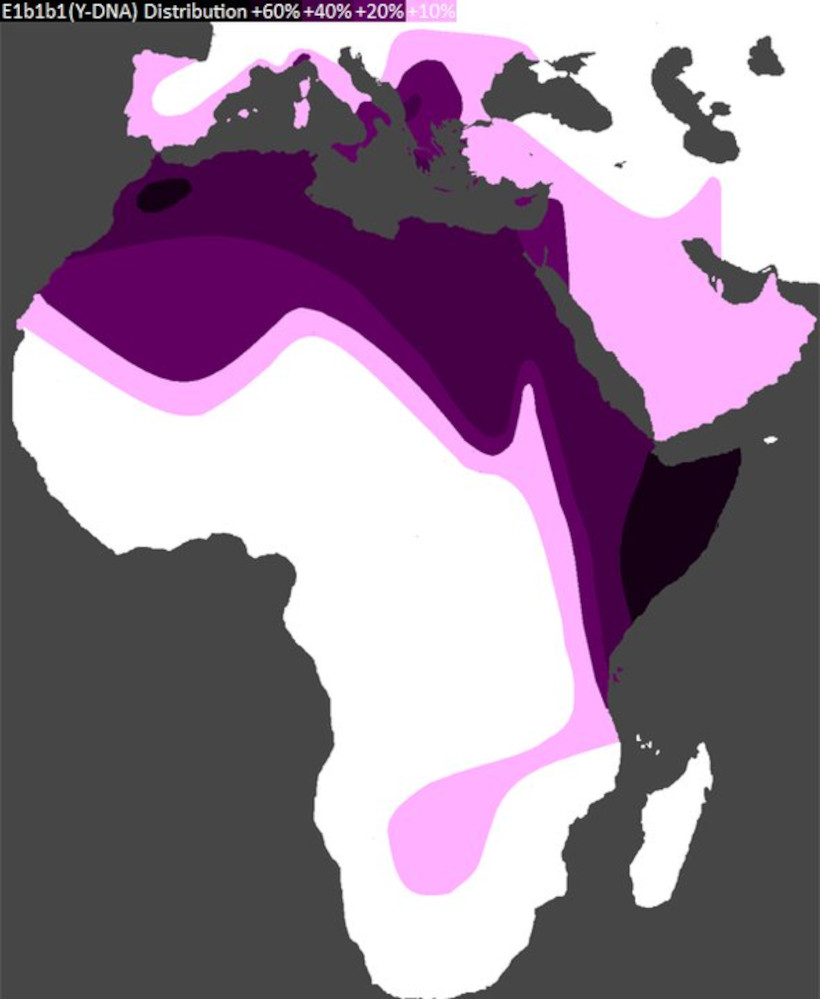
Holsonback
Bi Smith's mother was Catherine Holsonbake, born 1837 in Franklin County Georgia. Her
father was Lewis D Holsonback, born 1791 in Edgefield County South Carolina. A cousin
claimed the D stood for Delano, according to a family Bible. But Lewis's grandfather
was acquainted with a man named Matthew Devore, and Lewis's father was Matthew D. To
top it off, a Lewis D who descended from Lewis was called Lewis Devore in his obituary in Oklahoma.
Therefore I'm certain that Catherine's father was Lewis Devore Holsonback and his father
was Matthew Devore Holsonback, born 1766 in Ninety-Six District South Carolina.
Before I learned how to use ThruLines to break down genealogical brick walls, I did a
lot of manual census searching on the Holsobacks. I determined that Matthew was Lewis's
father that way. Now that I can use ThruLines, it only returns one match for Matthew.
It's possible that Lewis's father was Matthew's brother, but that would be odd given the
proven Devore name inheritance. My assumption is that all other ancestry.com members
have the wrong information, and ThruLines attempts to defend it. ThruLines returns lots
of matches for Lewis's mother, Polly Hughes, though it can't make connections to her
siblings. The family moved to Coffee County Tennessee on its way in Catherine's
generation to Kentucky. Both Matthew and Lewis moved to Georgia before then, where
Lewis raised his family, which helped in the census analysis to connect them. Matthew's
father was Abraham, born 1741 in Pennsylvania. Abraham's father was Derrick, who
immigrated to Pennsylvania in 1738. He followed as the next generation went to North
Carolina. Abraham went from there to become the South Carolina family patriarch.
Derrick immigrated from the Baden state of the Rhineland of what was then called the Holy
Roman Empire and would eventually be Germany. His name had been Johannes Diterich
Helsenbeck. His father had the same name, and his grandfather was Johann Jurgen
Halsenbach. Baden is in the west of Germany, in what was also called the Palatinate.
Many Germans immigrated to America from there, including other lines of our family tree.
The reason as I understand it was instability over conflict with France and shifting
borders over the previous centuries. When I researched this line I heard of male
descendants believing it came to the Rhineland from eastern Europe. I wondered about that,
and now that I've looked at the Y-DNA of the line I understand. Their haplogroup is
R-M198, which is a part of R1a, the primary makeup of Eastern Europeans and Russians. See
the "heat map" below of R1a. Notice first that it's rare in the Rhineland. There is a
concentration on the east side of Germany around Berlin. Maybe the Halsenbachs had been
there, but either way they came to the Rhineland from the east. The Hartsells in the
Scott tree were a Swiss line of the R-M512 haplogroup, which has a similar eastern origin.
Presumably the Holsonbacks were Lutheran. They were considerable slaveholders in America.
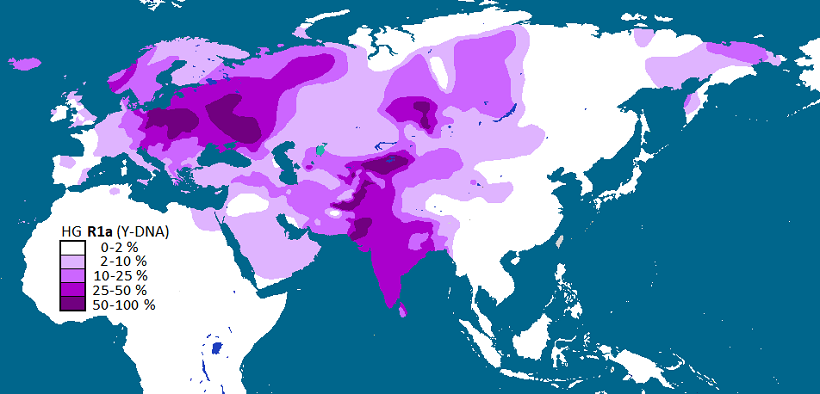
Distribution of haplogroup R1a
Hardin
For a long time, most of Joseph Hardcastle's family tree was obscured by brick walls. I didn't know
who his maternal grandparents were. And I didn't know who his father's mother was at
all. But I learned how to use ThruLines to break down those walls. I've always wondered
about his father's name, Hardin. Probably most people spell it Harden, as in English for
making harder. But I always thought it had a different meaning, and I spelled it Hardin.
In researching who John Hardcastle's wife could be, I looked for peers of his father,
Elisha Hardcastle. The entire family was in Rutherford County North Carolina by 1800, so
I started there. In the 1800 census I found neighbors named Hannon, Hackney, and Hambrick.
And I began to see Hardens. But then I realized these weren't neighbors. The 1800
Rutherford census was arranged alphabetically. This can be very convenient when you know
who you're looking for. But in the ThruLines educated guess methodology it's not good,
because neighbors were more likely to have children get acquainted and eventually marry.
I had no idea who Elisha's neighbors were. But in 1790 it wasn't alphabetical, and I found
neighbor names Penney, Johnston, Massey, Price, Averit, and Hinton. I was particularly
looking for Hancock, thinking that the John and Mary Hancock put as Hardin's parents in his
death record was a mess-up caused by Mary's maiden name having been Hancock. I had no luck
finding any. And then the name Harden stood out, though they weren't neighbors, and it
brought me back to my thoughts about it. Did our Hardin's first name come from a surname?
So, I worked from the surname Harden/Hardin. The next step in the process is to use
wikitree.com and geni.com and ancestry.com to find a man named Hardin who could've had a
daughter of age to wed John Hardcastle and both families' paths intersected where the
wedding occurred. I also assumed that the daughter's name was Mary. I then found a
Benjamin Hardin who was in the right place and had children in the right range of years.
I didn't know who his wife was, but I put him in the tree and Mary Hardin as his daughter
and John's wife. I also put in Benjamin's father, and ThruLines returned a few matches for
both of them. Not a slam dunk, but I think definitely a score. Benjamin was my ancestor,
born 1764 in Mecklenburg County North Carolina. I placed Mary Hardin's birth in Rutherford.
Benjamin's father was John Hardin, born 1732 in Henrico County Virginia. John's father was
Benjamin Hardin, born 1700 in Henrico. Benjamin's father was also named Benjamin, born in
1678. Now, the repeated use of the name Benjamin makes it clear that these are our
ancestors. But the eldest Benjamin's birthplace was a surprise. He was born on Staten
Island in New York. This was 14 years after the English had taken over from the Dutch.
This brings up the origin of the name Hardin. It's French, directly from France, from
Hardewyn. It turns out that Staaten Eylandt had a long history of French Huguenots, so
apparently our Hardins were part of that, even after the English took over. Benjamin's
father was Martin Hardin, born 1650, in as it turns out, Normandy. He apparently had family
on Staten Island and it was just a starting point for him, because after Benjamin was born, and presumably more children, he moved to
Virginia. Geni.com traces the line back in Normandy to the 16th century. The Huguenots
were Calvinist. The Hardins were slaveholders. The Hardin DNA project has no clear
connection to France for our line. There are several Benjamin Hardins. They're all of
haplogroup R-M269, but are attributed as being English. There are a few John Hardins who
were on a similar path, and were I-M253. So, it seems there are two possible sources of
our line: from Normandy who went to England after 1066 and became English, or from Normandy
who remained there until the 17th century. And of these, they might've come from Vikings
and they might've come from Celtic Gauls.
Wilson
As told above, I used ThruLines to find Daniel Taylor as Mary's father. But I found no info on Daniel's wife. So, I had to use the same process to break down that brick wall. The Taylors were in early eastern Tennessee for a long time, which makes documenting their path difficult. I had to resort to the 1820 Pike County Mississippi census to find prospective parents who were peers of Daniel's parents. In that census I found neighbors John Wilson, John McClain, Gilbert Simpson, Archibald McLeod, and Duncan Finley. I began looking for John Wilson on wikitree.com and geni.com, with no luck, but then I found a Zaccheus Wilson who died in Sumner County Tennessee, and had a daughter born 1792 in Sumner. I put Ann Wilson as Daniel Taylor's wife, and Zaccheus and Margaret Russell as her parents. Unfortunately, ThruLines can't help to make sibling connections for the parents, and only one match was returned for Zaccheus. But there were seven for Margaret, which seems strong evidence that she was an ancestor and Wilson is the correct line here. Zaccheus was born 1765 in Mecklenburg County North Carolina. His father was Robert Wilson, born 1717 in Cumberland County Pennsylvania. Robert's father was John Wilson, born 1678 in Lisburn, Antrim Ireland. John's father was also named John, born 1650 in Cumnock, Ayrshire Scotland. As mentioned in the Scott tree, this Wilson line followed a very similar path to the Wilson line there, so John Jr might've been Sarah Wilson's father too. I assume this was a Presbyterian R-M269 line.
Morris
The initial information for JQA Smith was his mother's name was Elizabeth Morris, born
1805 in Ashe County North Carolina. ThruLines returned no matches, so even her maiden
name seemed in question. I looked into her maybe being related to the Morrises on my
dad's side, and though they both were in North Carolina and Tennessee, she didn't fit. She
was in eastern North Carolina while Isaac Morris was in Rowan County. By searching
wikitree for other Morrises, I found a John Oliver Morris born in Rutherford County
North Carolina, where Elizabeth wed at around the same time, so I figured they were
related. I found a Jesse Morris who was John's father, and a Zachariah who was Jesse's
brother. Guessing that Elizabeth was their sister, I put their parents in as hers, who
were John Morris and Elizabeth Highman. ThruLines returned one match each. In other
cases like this, I've gotten matches at the next generation to prove the ones in
question as correct. But this deep in the tree, ThruLines can't give matches to the
next generation.
Feeling unsure about having only one match at the endpoints in this tree, I did more
research in Rutherford censuses and found a Haton Morris. He had a son Reuben who was
a good fit as Elizabeth's father. When I put Reuben Morris and Lucy Moore in as
Elizabeth's parents, I got zero matches. But feeling that they were such a good fit,
I put in parents for them. And then ThruLines broke through and reported dozens of
matches for Haton, whose full name was John Haton/Hatton Morris. This is another
generation out from where ThruLines can usually help, but this is part of my mother's
mother's tree, and I have her autosomal DNA test. Once Haton/Hatton hit, then I got
lots of matches for Reuben. This case is very interesting for a couple of reasons.
One, it appears that putting in the next generation can help ThruLines sort things out,
when it looks like a person isn't an ancestor at all and they actually are. Two, this proves
that cases with one match can indeed be relations but not direct ancestors. There are
likely quite a few cases in my tree where I have siblings of my actual ancestors in it,
and I just don't know the correct names. As long as ThruLines can help with the next
generation, I can be certain that the surnames are accurate and the situation is
corrected at that next gen. But for the endpoints in the tree, where ThruLines can't
prove the next generation, some of them may be in error. Not much weight is put on
such persons though, and usually I don't have enough info to even plot the surname
residence path.
So, Reuben Morris was born 1769 in Rutherford County North Carolina. His father was
John Hatton Morris, born 1743 in Rowan County North Carolina. John's father was
Thomas Hatton Morris, born 1714 in Worcester England. This line is probably not
related at all to the Morris line on my dad's side, even though both were in Rowan
County a few decades apart. This Morris line seems to come correctly from French
Maurice, presumably of a Norman origin. There's not enough info to determine if they
were slaveholders. The Haton/Hatton Morrises have been tested as Y-DNA haplogroup
R-M269.
Glover
Catherine Holsonbake's mother was Barbara Glover, born about 1810 in Cabarrus County North Carolina. Barbara's father was William Glover, born 1665 in Cabbarus. This line gets iffy at William's father, as I have a William born 1711 in Surry County Virginia. ThruLines returns zero matches for him, but do support Ann Lowery as the younger William's mother. Proceeding with this line, there are actually four consecutive Williams. So we'll call Catherine's father William IV. William II was born 1678 in Henrico County Virginia. William I was born 1653 in Rappahannock County Virginia. His father was Richard Glover, born 1611 in England. A William Glover was acting governor in the Albemarle region, who may have been our William I. It looks like Glover was a Scotland/England border name, as it's more common in Scotland. I found a connection to Surry Glovers on their DNA project, and they were of Y-DNA haplogroup R-M269. This line is too early to know if they were slaveholders.
Van Buren
John Hardcastle's mother was Polly Van Buren, born 1754 in Dorchester County Maryland. Polly's father was Andrew Van Buren, born 1680 in Dorchester. Initially the only info I had for Mary was her maiden name and death in Tennessee. Her children were born in North Carolina. One lesson I learned with this line in the use of wikitree.com as a resource, is the page that lists all people in its database with a surname, it only lists birthplace. I found no Van Burens in North Carolina or Tennessee. The only place associated with the name was New York. So, I was at a loss to explain how she got to North Carolina. I already knew that Van Buren is a Dutch name, and that brought to mind the Youngbloods on my dad's side. They had been in New York and ended up in the south. They did this by first moving to Maryland. So, I looked on wikitree for Van Burens in Maryland, and I found none. I then resorted to investigating men from New York who were of age or earlier to have been Polly's father. In that way I discovered that there were Van Burens associated with Maryland, and that was how I found Andrew. I know nothing else about this line. The Hardcastles weren't in Maryland, but they were on the Potomac, and that must've been how Elisha met Polly. It seems quite possible that our Van Burens followed the same path as the Youngbloods and were a part of New Amsterdam before the English changed it to New York. I presume that they were Catholic, having gone to Maryland. There's no Van Buren DNA project, so I have to guess haplogroup R-M269.
Scott
Ancestry.com gave no hint of who Mary Hardin's mother was. The only lead I have is geni.com, which has her named Elizabeth Scott, born 1766 in North Carolina. It has her father as John Scott, born 1730, location unknown. Obviously to me, this brings to mind my own paternal line which has a John Scott born 1734 who could've been considered living in North Carolina at one time in his life. I have no idea if this Elizabeth was related to my line. She could be completely unrelated. It's remotely possible that she was a sister of Andrew Scott and John Wilson Scott. She might've been the daughter of one-armed John Scott of North Carolina. I don't have enough info to say. ThruLines returns only one match. But I presume this line was Presbyterian and R-M269.
Rouse
Daniel Jr Taylor's mother was Elizabeth Rouse, born 1760 in Culpeper County Virginia where Madison County would be formed. Elizabeth's father was Matthias Rouse, born 1723 in Spotsylvania County Virginia. Matthias's father was John Rausch, born about 1690 in Siegen of Westphalia, which would eventually become part of Germany. Siegen is about 50 miles east of Cologne. Presumably this line was Lutheran. A DNA project that includes Rouse has a Johan Caspar Rausch of Germany who was of haplogroup R-Z307. This is a branch from the Frisian haplogroup R-U106, which is in the Netherlands.
Russell
Zaccheus Wilson's wife was Margaret Russell, born 1765 in Mecklenburg County North Carolina. Margaret's father was David Russell, born 1733 in Virginia. This line becomes uncertain at his father and the county of his birth, with the possibility that it came from Leath Ireland. Russell is a Norman English name meaning red-headed. I make the usual assumptions for an English line here.
Bulcock
JQA Smith's paternal grandmother was Anne Bulcock, born 1775 in Brunswick County North Carolina. Anne's prospective father was William Bulcock born 1752 in Leistershire England. I say prospective because he never left England. If he was an ancestor, this means that JQA's grandfather James Smith was wealthy enough to make multiple trips between North Carolina and England. The name Bulcock comes from a town called Baldock in England. Now, Bulcock seems strange enough for anyone to have chosen as a surname. But actually the appendix 'cock' was very common in English surnames, meaning brash or bold of character. Cocksure. Witness Hancock. In the case of Bulcock the name obviously shifted from its origin. But Baldock is an equally unusual name. Apparently this shifted from its original form, which was founded by the Knights Templar after a crusade. The story is that it was named after what's now called Baghdad. I don't think those Templars were so dumb that they couldn't spell Baghdad. One, I expect that it probably had a different form back then, and two, as I said I think Baldock is a shift from whatever that original name was. The English always attempt to turn a foreign name into English. In this case, 'dock' is an English word. I make the usual assumptions for an English line here.
Moore
Elizabeth Morris's mother was Lucy Moore, born 1765 in Virginia. Lucy's father was Alexander Moore, born 1730 in Dundee Scotland. This is all I have on this line. Morris certainly is an odd name amongst my ancestors. Elizabeth's line seems to follow the known descendance from French Maurice. But Morris on my dad's side was incorrectly adapted from Moore, or Moores. And now, Elizabeth's mother was a Moore. Irony abounds. It is known that the name Moore, from living by a moor, is a surname in both England and Scotland. Given that this line went directly to Virginia, I assume they were anglican and otherwise similar to a typical English line.
Hughes
Matthew Holsonback's wife was Polly Hughes, born 1773 in Person County North Carolina. Polly is a significant proof that I have the Holsonback line correctly, though most Holsonback researchers don't have Matthew as Lewis's father. ThruLines solidly support Polly. Her father was John Hughes, born 1753 in Baltimore Maryland. This is uncertain, and who his father was is uncertain. Even the origin of the surname Hughes is uncertain. I believe it was Welsh, and this otherwise was a typical English line.
Crider
Barbara Glover's mother was Barbara Crider, born 1772 in Lancaster County Pennsylvania. Barbara Crider's father was called Jacob Crider. I don't know anything else about him. Houseofnames.com says Crider is a pre-Norman English name, but it sounds German to me and that would fit with passing through Pennsylvania. But I'll assume this is a typical English line without more info.
Summary of Thomas Hardcastle's Great-Great-Grandparent Lines
Three of the sixteen lines are confirmed slaveholders. I would guess that not a lot
more of them actually were, but we don't have information for most of them, as they
lived too long ago to leave records. Hardcastle is an English line, and half of
Thomas's ancestors were English. The other half was quite diverse, with German,
Scottish, French, and Dutch. Likewise they were half Anglican, and otherwise
Lutheran, Presbyterian, Catholic, and Calvinist. They were three-quarters of Y-DNA
haplogroup R-M269, but many of these are guesses. The remainder were interesting
haplogroups R-M198, R-U106, and E-M35. Only the R-M269 Y-DNA came down to us, but the
others do help in understanding where Thomas Hardcastle's ancestors came from. I didn't
attempt to define a migration path below for the earliest lines.
Migration paths
Hardcastle: 1917 Byars, McClain, Oklahoma - 1891 Newhope, Pike, Arkansas - 1855 Gasper, Logan, Kentucky -
1820 Carthage, Smith, Tennessee - 1800 Rutherfordton, Rutherford, North Carolina - 1763 Selma, Johnston, North Carolina -
1750 Gloucester, Gloucester, Virginia - 1685 New Kent, New Kent, Virginia - 1625 Warsaw, Rappahannock, Virginia -
0 Pateley Bridge, Yorkshire, England
Smith: 1853 Manchester, Coffee, Tennessee - 1830 Charlotte, Mecklenburg, North Carolina - 1800 Rutherfordton, Rutherford, North Carolina -
1760 Southport, Brunswick, North Carolina - 1690 Berkeley, Perquimans, North Carolina - 0 Lincoln, Lincolnshire, England
Taylor: 1780 Carthage, Sumner, North Carolina - 1745 Orange, Orange, Virginia - 1700 Fairfax, Fairfax, Virginia -
1670 St Marys, St Marys, Maryland - 0 Carlisle, Cumbria, England
Holsonback: 1850 Manchester, Coffee, Tennessee - 1830 Carnesville, Franklin, Georgia - 1765 Edgefield, Ninety Six, South Carolina -
1735 Langhorne, Bucks, Pennsylvania - 0 Halsenbach, Rhineland, Baden
Hardin: 1790 Rutherfordton, Rutherford, North Carolina - 1760 Charlotte, Mecklenburg, North Carolina - 1700 Henrico, Henrico, Virginia
1675 Staten Island, New York, New York - 0 Rouen, Normandy, France
Wilson: 1790 Carthage, Sumner, North Carolina - 1760 Charlotte, Mecklenburg, North Carolina - 1710 Carlisle, Cumberland, Pennsylvania -
1675 Lisburn, Antrim, Ireland - 0 Cumnock, Ayrshire, Scotland
Morris: 1800 Ashland, Ashe, North Carolina - 1765 Rutherfordton, Rutherford, North Carolina - 1740 Salisbury, Rowan, North Carolina -
0 Worcester, Worcestershire, England
Glover: 1760 Harrisburg, Cabarrus, North Carolina - 1700 Surry, Surry, Virginia - 1675 Henrico, Henrico, Virginia -
1650 Warsaw, Rappahannock, Virginia - 0 Carlisle, Cumbria, England
last edited 29 Aug 2022
